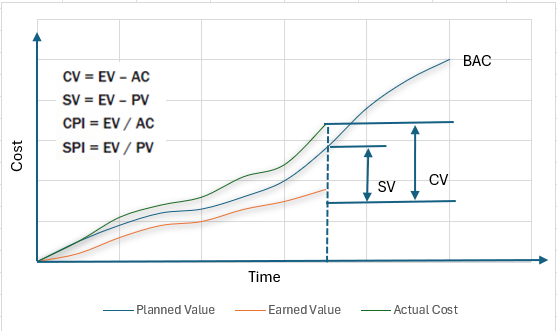Integration Management
Development Approaches and Life Cycles


Life Cycles & Process Groups (Predictive)

Life Cycles & Process Groups (Adaptive- Agile)

Process Groups & Knowledge Areas

Economic Project Selection
Present Value
Example
PV = Present Value
FV = Future Value
r = Interest Rate
n = number of time periods
PV = FV / (1+r) ^n
PV =?
FV = $200,000
r = 10%
n = 2
PV = $200,000 / (1+.1) ^2
PV = $165,289
Net Present Value
Example
NPV = Net Present Value
r = Interest Rate or return rate
n = number of time periods
NPV = Cashflow / (1+r) ^n

Internal Rate of Return (IRR)
Example
For the IRR, is calculated at NPV = 0, so in this example IRR = 9.18

Payback Analysis
Example
Payback = Cost of the Investment / Average Annual Cash Flow

Depreciation
Formulas
- Straight Line Depreciation: Same amount of depreciation each year.
- Accelerated Depreciation:
- Declining Balance
- Double Declining Balance

Project Management Plan


The Managment plans not only includes Knowledge areas, but also Requirements, Change, Configuration, and process improvements Managment Plans.
Requirement Management Plan
Change Management Plan
How the stakeholder's requirements will be Identified, Analyzed, evaluated, prioritized, and documented, as well as how the requirements will be managed and controlled.
Configuration Management Plan
Part of the PMIS, which contains the organizations' standardized configuration management tools, processes and procedures that can be used to track and control the project documentation
Process Improvement Management Plan
Process improvements discovered during the project that facilitate and help to finish some activities and/or the project faster.
Describe how changes will be managed and controlled and may include:
- Change Control Procedures
- Approval levels for changes
- Change control board to approve changes with roles and responsibilities
- Plan to outline how changes will be managed and controlled
- Who will be attending change meetings
- Tools to track and control changes
- Reports of outcome of change requests
- Emergency change process
PMIS: Project Managment Information System - Software to control changes
Scope Management
Define what work is required, then make sure that the work is completed, only that work, no more.
Collection Requirement Methods:
- Historical Records
- Interviews
- Focus Groups
- Workshops
- Brainstorming
- Nominal Group Technique (Ranks Ideas)
- Multi Criteria decision Analysis (Ranks Ideas)
- Mind Maps
- Affinity Diagrams
- Questionaries and Surveys
- Observation
- Prototypes
- Benchmarking
- Context Diagrams
- Group Decision Making
- Delphi Tecnhique
Outputs:
- Scope Managment Plan:
- How the scope will be planned
- Executed
- Controlled
- Requirement Management Plan
RTM

Project Performance Domains

Planning Performance Domain
Estimates:


Schedules for a Predictive Approach:
Steps:
- Decompose the project scope into specific activities
- Sequence related activities
- Estimate the effort, duration, people, and physical resources to complete the activities
- Allocate people and resources based on availability
- Adjust the sequence, estimates, and resources until an agreed-upon schedule is achieved
Project Work Performance Domain
Steps:
- Managing the flow of existing work, new work, and changes to work.
- Keeping the project team focused.
- Establishing efficient project systems and processes.
- Communicating with stakeholders.
- Managing material, equipment, supplies, and logistics.
- Working with contracting professionals and vendors to plan and manage procurements and contracts.
- Monitor changes that can affect the project.
- Enabling project learning and knowledge transfer.
Delivery Performance Domain
Well documented requirements meet the following criteria:
- Clear. there is only one way to interpret the requirement.
- Concise. The requirement is stated in a few words as possible.
- Verifiable. The is a way to verify that the requirement has been met.
- Consistent. There are no contradictory requirements.
- Complete. The set of requirements represents the entirety of the current project or service needs.
- Traceable. Each requirement can be recognized as a unique identifier.
Measurment Performance Domain
Baseline Performance:
BAC = Budget at Completion
EV = Earned Value
CV = Cost Variance
SV = Schedule Variance
CPI = Cost Performance Index
SPI = Schedule Performance Index

Forecast:
ETC = Estimate to Complete
EAC = Estimate at Completion
VAC = Variance at Completion
TCPI = To Complete Performance Index

Dashboard Example:
Information Radiators:

Risk Over Time:

Burnup Charts

Uncertainty Performance Domain

Gantt Example

Create Your Own Website With Webador